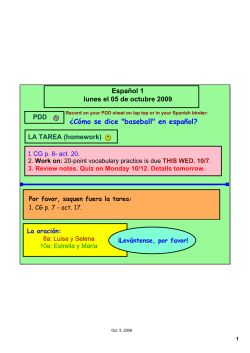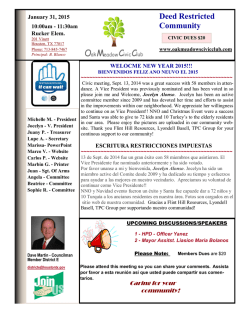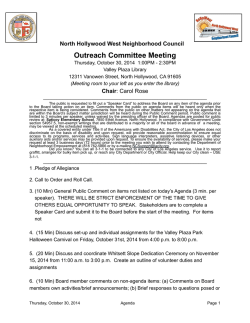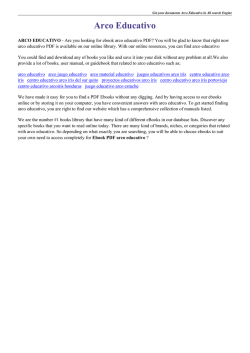
El pez arcoiris
Literacy Squared® Lesson Plan Teacher/s: Bare, Stewart, Knudson, Lopez, Angulo, Abarca School: Migrant Ed Grade: Spring Kinder Literacy Standards: L.I.2 Con sugerencias y apoyo identifican el tema principal y recuentan los detalles clave de un texto; LL.3 Con sugerencias y apoyo, identifican personajes, escenarios y acontecimientos importantes en un cuento; E.3 Usan dibujos, dictado y escritura para narrar eventos ELP Standards: Describe; using nouns Literacy Objectives: SWBAT identify characters, settings, and major events in a story Connections between Literacy Cross-language Strategies (if Environments: applicable): Materials: El pez arco iris por Marcus Pfister Non-fiction books on fish and sea creatures Canción: Un pulpito por Charlotte Diamond Fish Faces by Norbert Wu Cognates: Conventions Cueva/cave Capital letter to start sentences, spaces between words, punctuation at the end of a complete sentence. Océano/ocean contento/content (feeling) brillante/brillant Grammatical Structures of Language respeto, respect Verbs: Action words preciosas/precious Adjectives: Describe nouns Nouns: Person (animal), Place, or Thing (body parts) marchar/march (verb) maravillosas/marvelous camaflage/camoflage depredator/predator Dictado en español: El pez El pez dijo-Te doy una escama. English Dictado: Sea Star The red sea star has five arms. Enfoque de instrucción: El guillión, mayúscula/minúscula, espacios, punto final Teaching Points: /s/, capital/lowercase Lecto-escritura Literacy Squared® 2/2012 Literacy-based ESL 1 Objetivo(s) de oralidad: SWBAT describe characters in the story, identify key story elements, and discuss perspectives. Oracy Objective(s): SWBAT make descriptive observations about the different sea animals. Diálogo: Beginning: ¿Has visto un pez? ¿Qué características tiene un pez? Un pez____. Un pez tiene ______. Middle: ¿Cómo sintió el pez arco iris/ el pez azul cuando _____, y por qué? ¿Cuáles consejos le dio el pulpo, y por qué? ¿Cómo te sentirías si fueras el pez arco iris/el pez azul/ el pulpo? Dialogue: Where have you seen a fish/octopus? Have you ever been to the beach? Aquarium? Mark Hatfield Marine Science Center... Have you eaten any sea creatures before? Estructuras lingüísticas: ¿Quienes son los personajes? ¿Qué pasó primero?/más tarde? finalmente? ¿Cuál fue el problema?/la solución? ¿Qué pasó ________? ¿Comó se sintió el ____________? El pez se sintió ________ porque _________. Yo me sentiría _________porque _________. Language Structures: What does a ______ look like? A(n)/The ___ has ____.; A(n)/The _____ has _____and _______. A(n)/The ________is ________. A(n)/The ________ is ________and __________. Vocabulary: scales, fins, arms, legs, dorsal fins, eyes, mouth, tail, octopus, deep ocean (under the sea); surface of the sea; cave, beach, sand, waves, fish, shark, whale (humpback/killer), sea horse, sea turtle, Mi personaje favorito es ________ porque __________. Vocabulario: escenario, personajes, problema, solución, alegre/triste, contento/frustrado, compartir Vocabulary for Review: escamas, aletas, brazos, patas, aletas dorsal, ojos, boca, cola, pulpo, profundo del mar, superficie del mar, cueva, playa, camuflaje Literacy Squared® 2/2012 2 Evaluación: EDL Assessment DRA; My Book of Sea Animals; SWBAT write a sentence using sentence start: The (noun)______. Students can use: The ____has _____. or Expresión oral (hablar y escuchar) Escritura: Using the arco iris picture, students fill in each part of the story The _____has ____and _______. map on one side, and the back draw a picture that includes characters, setting, Speaking/Listening Students will practice language structures with a partner (lines of communication, peanut butter jelly, etc.) problem, and solution. Lectura: Author’s Chair sharing their favorite character from el pez arco iris. Writing Students will write sentences using language supports (My Book of Sea Animals). Reading: Students read their booklets to others (busy bees/peanut butter jelly/chips and salsa)/Ocean Animal Chants Lecto-escritura Literacy-based ESL (M=Modelado, C=Compartido, E=Equipos/parejas, I= Independiente) (M=Modeled, S=Shared, C=Collaborative, I=Independent) Lectura Literacy Squared® 2/2012 Escritura Reading Writing 3 Sess Enfoque pedagógico: M ion C E I 1 Texto: El pez arco iris Enfoque pedagógico: Approach: M I C E Actividades: I M Text: Fish Faces SG C Approach: I M S C Activities: Activities: Model how to use sticky notes for Actividades: Prior knowledge Modeled/Collaborative writing of prior activity (KWL or informal questioning knowledge on KWL Chart. Observation charts with different sea questions and comments, and let them know they can use symbols (star for on fish and personal experiences with creatures. comment, question mark for question) sharing or problems with friends) Dictado Pictures in separate document if they can’t write the question. Picture Walk/Caminata Students begin to make observations Picture Walk with a partner. Read book the text Literacy Squared® 2/2012 4 Sess Enfoque pedagógico: M ion C 2 Texto: El pez arco iris Enfoque pedagógico: M Approach: C Text: Read Non-Fiction E I Actividades: Activities: M S C I Approach: I M S C Activities: Column titles: Animals, Body Parts: Teeth, Eyes, Skin, How do they move, Dictado Revisit observation charts and as a Actividades: group make a chart of nouns. Introduce Retell Rubric (Traffic Light) Teacher models Fish Input Chart while Sequence the story, include the scene, Explain that everyday we are focusing on a different element of the story. Pick a non-fiction picture book on sea students label their own. characters, problem and solution) animals or sea life, and front load Use different colors for the different vocabulary. Present the story map in the fish elements of a story. graphic. Read the book. -Face: Characters Use the questions from dialogo y -Aleta Dorsal: Setting estructuras lingüísticas. -Body: Problem (Al principio, El medio) -Tail: Solution Literacy Squared® 2/2012 5 Sess Enfoque pedagógico: M ion C E I 3 Actividades: Write on the dorsal fin, the setting/ where the story takes place. (En el océano, en el profundo del mar, en una cueva) Use the Fish Story Map Enfoque pedagógico: M C E I Approach: I M S C Approach: M S C I Text: Read Non-Fiction Ocean Book Activities: Actividades: Modeled writing of favorite character Modeled writing with Adapted using language structure. Activities: Sentence Patterning Chart; Dictado Sentence Patterning Chart Noun/Verb (has)/Noun; and Adj/ Noun. Shared writing with Adapted Sentence Patterning Chart; If you have the CD, play What/Who is it? with the sounds of the sea. In Alternatively, can use pictures from groups of 2-3 students will listen to observation charts. the sounds and then write what they think made the ocean sound is. Prepare sentence strips with nouns and adjectives from yesterday’s written list. What does a _____ look like? The____has ____. A _____ has____and____. The _____is _____. The___is___and ____. Literacy Squared® 2/2012 6 Sess Enfoque pedagógico: M ion C E I 4 Enfoque pedagógico: M C E I Actividades: Actividades: Work on the Fish graphic: Body (the Teacher will write the students ideas problem) include “in the beginning” and for the problem in the graphic, while teacher is writing, students will write on “then”, “later”... their copy of the graphic. When Present the idea of a problem in the complete the students will find a partner with whom they will read their story. Refer to questions in writing. Estructuras lingüísticas. When students are in agreement of Students vote for favorite character the problem, the teacher will write their and collaboratively write. Call on volunteers for writing ideas/reasoning. ideas on the graphic. Using pictures from Second Step, or other pictures that represent social problems; ask the students to use post-it notes to write the problem that they see. Use the observation chart format. Later, they will read their ideas to a partner. Gather as a whole group and share what they wrote. Collaboratively, come up with possible solutions. Literacy Squared® 2/2012 Approach: I M S C Activities: Students will chorally read the sentences from the writing activity. Approach: M S C I Activities: Model sentence frames using supports for writing. Model taking vocabulary from Adapted Sentence Patterning Chart to make sentences. Students will read their sentence to a neighbor. Then, call on students to come up and write a noun of their choice. If time permits, have students go to their student journals to write their own sentence, then draw a picture that matches their sentence. Have them read their sentences to a neighbor. *Sentence Frames: PDF attached** Sentence Patterning could be glued into journals for a gradual release. 7 Sess Enfoque pedagógico: M ion E I 5 Texto: C Enfoque pedagógico: C E I Approach: M I M S C Approach: I M S C Text: (Student Made) My Book of Actividades: Sea Animals Activities: Students will write in their journals about their favorite character from Activities: Actividades: Students will write sentences to match the story using the supporting sentence Author’s Chair frame: Mi personaje favorito Busy Bee reading of their books to a picture. Students will read their sentence about es___porque_______. partner. their favorite character to the class Then, they will draw a picture of the and share their picture. character. Students are encouraged to use more than 3 colors in their drawing. Ocean Themed Book List Spanish Non Fiction: La ballena azul: El mamífero más grande del mundo por Joy Paige Las ballenas jorobadas por Susan Watson La medusa por Lola M. Schaefer Vida Animal Delfines y marsopas por Sally Morgan Vida Animal Tortugas y Galápagos por Sally Morgan Caras de peces por Norbert Wu ¿Cuánots peces? por Alan Rubin Bajo las olas por Kristin Joy Pratt Bajo las olas 1, 2, 3 por Barbara Knox Corales por Capstone Press Focas por Capstone Press Pulpos por Carol Lindeen Tiburones por Carol Lindeen Literacy Squared® 2/2012 Estrellas del mar por Rake, Jody S. and Gail Saunders-Smith Pez payaso por Capstone Press 8 English Fiction The Three Little Fish and the Big Bad Shark by Ken Geist Rainbow Fish to the Rescue by Marcus Pfister Commotion in the Ocean by Giles Andreae Hello Ocean by Pam Munoz Ryan I’m the Biggest Thing in the Ocean by Kevin Sherry In One Tidepool: Crabs, Snails, and Salty Tails by Anthony Fredericks Over in the Ocean: In a Coral Reef by Derkes, Marianne and Canyon Non Fiction Oceans: Dolphins, Sharks, Penguins and more! by Johnna Rizzo Eye Wonder: Ocean by Sue Thornton Literacy Squared® 2/2012 9
© Copyright 2025



